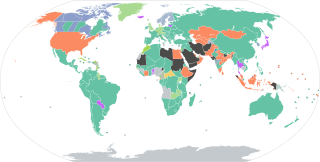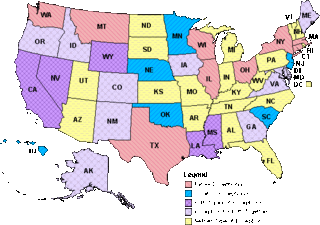
An adult is a human or other animal that has reached full growth. The biological definition of the word means an animal reaching sexual maturity and thus capable of reproduction. In the human context, the term adult has meanings associated with social and legal concepts. In contrast to a non-adult or "minor", a legal adult is a person who has attained the age of majority and is therefore regarded as independent, self-sufficient, and responsible. They may also be regarded as a "major". The typical age of attaining legal adulthood is 18, although definition may vary by legal rights, country, and psychological development.

Driving under the influence (DUI) is the offense of driving, operating, or being in control of a vehicle while impaired by alcohol or drugs, to a level that renders the driver incapable of operating a motor vehicle safely. Multiple other terms are used for the offense in various jurisdictions.

Mothers Against Drunk Driving (MADD) is a non-profit organization in the United States, Canada and Brazil that seeks to stop drunk driving, support those affected by drunk driving, prevent underage drinking, and strive for stricter impaired driving policy, whether that impairment is caused by alcohol or any other drug. The Irving, Texas-based organization was founded on September 5, 1980, in California by Candace Lightner after her 13-year-old daughter, Cari, was killed by a drunk driver. There is at least one MADD office in every state of the United States and at least one in each province of Canada. These offices offer victim services and many resources involving alcohol safety. MADD has claimed that drunk driving has been reduced by half since its founding.
John Malcolm McCardell Jr. is an American historian and academic administrator. He served as the President of Middlebury College from 1992 to 2004 and as the Vice-Chancellor and President of Sewanee: The University of the South from 2010 to 2020.

The legal drinking age is the minimum age at which a person can legally consume alcoholic beverages. The minimum age alcohol can be legally consumed can be different from the age when it can be purchased in some countries. These laws vary between countries and many laws have exemptions or special circumstances. Most laws apply only to drinking alcohol in public places with alcohol consumption in the home being mostly unregulated. Some countries also have different age limits for different types of alcohol drinks.

The National Minimum Drinking Age Act of 1984 was passed by the United States Congress and was later signed into law by President Ronald Reagan on July 17, 1984. The act would punish any state that allowed persons under 21 years to purchase alcoholic beverages by reducing its annual federal highway apportionment by 10 percent. The law was later amended, lowering the penalty to 8 percent from fiscal year 2012 and beyond.

William G. Durden is a former president of Dickinson College. He was a Fulbright scholar and a recipient of the Klingenstein Fellowship from Teacher's College, Columbia University.

Although the minimum legal age to purchase alcohol is 21 in all U.S. states and most territories, the legal details for consumption vary greatly. Although some states completely ban alcohol usage for people under 18, the majority have exceptions that permit consumption.
Choose Responsibility is a non-profit organization in the United States, that promotes public awareness of the dangers of excessive and reckless alcohol consumption by young adults. The main goal is to lower the minimum legal drinking age by educating the public. It was founded and is directed by Dr. John McCardell, Jr., president emeritus of Middlebury College.

Charles R. Middleton served as the President of Roosevelt University from 2002 to 2015 when he retired.

The youth rights movement seeks to grant the rights to young people that are traditionally reserved for adults, due to having reached a specific age or sufficient maturity. This is closely akin to the notion of evolving capacities within the children's rights movement, but the youth rights movement differs from the children's rights movement in that the latter places emphasis on the welfare and protection of children through the actions and decisions of adults, while the youth rights movement seeks to grant youth the liberty to make their own decisions autonomously in the ways adults are permitted to, or to lower the legal minimum ages at which such rights are acquired, such as the age of majority and the voting age.
Foundation for Advancing Alcohol Responsibility (Responsibility.org), formerly known as the Century Council, is an American not-for-profit organization founded in 1991 and funded by a group of distillers that aims to fight to eliminate drunk driving and underage drinking and promotes responsible decision-making regarding alcohol use.

The alcohol laws of the United States regarding minimum age for purchase have changed over time. In colonial America, generally speaking, there were no drinking ages, and alcohol consumption by young teenagers was common, even in taverns. In post-Revolutionary America, such laxity gradually changed due to religious sentiments and a growing recognition in the medical community about the dangers of alcohol. The more modern history is given in the table below. Unless otherwise noted, if different alcohol categories have different minimum purchase ages, the age listed below is set at the lowest age given. In addition, the purchase age is not necessarily the same as the minimum age for consumption of alcoholic beverages, although they have often been the same.
Medical amnesty policies are laws or acts enacted protecting from liability those who seek medical attention as a result of illegal actions. Such policies have been developing most notably in colleges in the United States regarding alcohol use by students. Schools such as Cornell University have implemented such policies to protect students seeking medical attention from illegal action for underage drinking and possession of alcohol and/or other drugs. The purpose of such policies is to reduce the hesitation caused by fear of legal action to seek medical attention. Similar policies are applicable at many levels: colleges and universities, local communities, as well as state governments. In 2012, The Medical Amnesty Initiative was started with the specific purpose of advocating for the introduction, passage, and education of medical amnesty legislation throughout the United States.

Alcohol laws are laws relating to manufacture, use, being under the influence of and sale of alcohol or alcoholic beverages. Common alcoholic beverages include beer, wine, (hard) cider, and distilled spirits. Definition of alcoholic beverage varies internationally, e.g., the United States defines an alcoholic beverage as "any beverage in liquid form which contains not less than one-half of one percent of alcohol by volume". Alcohol laws can restrict those who can produce alcohol, those who can buy it, when one can buy it, labelling and advertising, the types of alcoholic beverage that can be sold, where one can consume it, what activities are prohibited while intoxicated, and where one can buy it. In some cases, laws have even prohibited the use and sale of alcohol entirely.
Binge drinking is the practice of consuming excessive amounts of alcohol in a short period of time. Due to the idiosyncrasies of the human body, the exact amount of alcohol that would constitute binge drinking differs among individuals. The definitions of binge drinking are also nuanced across cultures and population subgroups. For example, many studies use gender-specific measures of binge drinking. The epidemiology of binge drinking likewise differs across cultures and population subgroups.
The legal drinking age varies from country to country. In the United States, the legal drinking age is currently 21. To curb excessive alcohol consumption by younger people, instead of raising the drinking age, other countries have raised the prices of alcohol beverages and encouraged the general public to drink less. Setting a legal drinking age of 21 is designed to discourage reckless alcohol consumption by youth, limiting consumption to those who are more mature, who can be expected to make reasonable and wise decisions when it comes to drinking.
Youth is an age group in the demographics of the United States. In 2010, it was estimated that 20.2% of the population of the United States were 0–14 years old.
Charles A. Hurley, commonly known as Chuck Hurley, is an American road safety campaigner. He was the Mothers Against Drunk Driving CEO from 2005-10.











